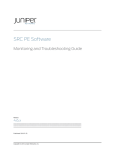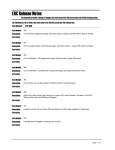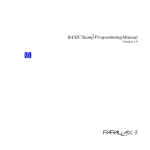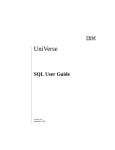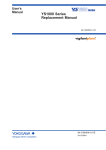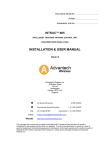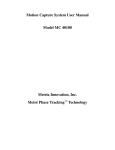Download WebX Guide - Dimitri (dim) Tools HOMEPAGE
Transcript
WebX Guide
WebX
User's Guide
(dim)
v.2.0
April 1999
Preface
Installation
First View...
Standard WebX commands
SET
INCLUDE
SHELL
IF
QUIT
ERROR
WHILE
UNLINK
FILE
COOKIE
FUNCTION & CALL
1
WebX Guide
REPLACE
FILE I/O
PROCESS I/O
SLEEP
CHDIR
COMPILE
HTML
COMMENTS
In−Line Values and Functions
Database interface
Other features
Preface
This software I've developed for my personal pleasure. It's a compilation of some my ideas which I wanted to see realized and used in Dynamic Web
and Data Base developing. The goal of this product is to make our life more easy :) I say it every time when I develop something, but is it true for
WebX − it's up to you...
So, I always wanted to have a kind of program which can be started with same interfaces on my Web server/browser and on my screen in shell mode.
Second, I want to avoid any problems with design and result presentation of this program. The most simple and popular language today is HTML, and
it's always more sample (in idea) to add several dynamic commands into existing page, than to put the whole page description into the program code.
That's why I've decided to write a program capable to add an HTML extension into already existing or completely new pages, to have more softness in
development.
And today you can find a lot of product with the same idea and sometimes doing the same thing... So, what is different? REALIZATION! :−) I propose
you my realization, which is started from the begin of 1995 and continues its life. For the moment I've ported it on INFORMIX, ORACLE, MySQL
and PostgreSQL, of course it turns on any UNIX, no comments for NT. :))
Installation
If you've downloaded the full binary pre−installed version you have just to follow the included installation notes, install the product and skip this
section. In other way, if you want to personalize your installation or modify it − don't skip.
So, before to do anything you have to be sure what do you want:
• if you want to use WebX on your Web server you need first to have HTTP server already installed;
• if you want to have an access to the database via WebX you need to have already installed Server or Client software for this RDBMS;
• you have nothing to do if you want to use WebX as a shell tool, why not...
Now you can install WebX:
• First, you need to create /WebX directory
$ mkdir /WebX
Installation
2
WebX Guide
$ cd /WebX
• Second, you have to create your environment file named "x.env" and which contains all environment values you wish to be useful to set
during WebX execution. The format of this file is very sample: each line represent a value setting follows syntax NAME=VALUE.
For example:
$ cat x.env
PATH=/usr/bin:/sbin:/informix/bin:/oracle/bin
TMP_DIR=/tmp
INFORMIXDIR=/informix
INFORMIXSERVER=ol_goldgate
ORACLE_HOME=/oracle
ORACLE_SID=dim
MYSQL_HOST=goldgate
$
Note: the TMP_DIR is the reserved name and it's used to specify the WebX temporary directory. The default value is "/tmp".
• The last you need to create your WebX config file named "x.config". Each line in this file represents the WebX instance configuration for
one HTTP server. The line format is follow:
ServerName:Port RootDirectory DefaultDataBaseName [hold]
• ServerName and Port − your HTTP server name and its port number. For using WebX in shell mode you have to put here shell:00
• RootDirectory − the name of the root directory for WebX script files, so only files from this directory and its subdirectories can be executed
for the current server configuration. As WebX is a kind of page interpreter this restriction protect your site against "hacking" interpretations
of any other files from your hard disk (like /etc/passwd for example).
• DefaultDataBaseName − the default database name uses for any database connection, can be replaced by "−" if the database name is taken
from environment variable (like ORACLE_SID)
• hold − is optional value that protect the database name changement for the current server configuration.
For example:
$ cat x.config
goldgate:80 /WebX/goldgate −
goldgate:81 /WebX/admin db_admin hold
shell:00 /WebX/shell −
$
Note: you can change the default "/WebX" directory by setting the X_HOME value in your environment for personal use and development.
Now you can copy WebX executable files to your server cgi−bin directory or in /usr/bin for using from shell (WebX − without db connections,
WebX.IFX − to communicate with INFORMIX, WebX.ORA − with ORACLE, WebX.pSQL − with PostgreSQL, WebX.mySQL − with MySQL)
First View...
So, every page files you places into the WebX RootDirectory for your server you can execute via standard cgi−bin URL adding your page name:
/cgi−bin/WebX/pagename or /cgi−bin/WebX?X_PAGE=/pagename
where X_PAGE is reserved variable for pagename settings.
From shell you can start it as:
$WebX pagename
Your page will be interpreted by WebX and the output will be placed to your browser or to your screen if you are in shell mode. Any additional
parameters can be passed using standard GET or POST method (HTTP server) or as command line parameters in shell mode. For example :
HTTP GET: http://yourhost/cgi−bin/WebX/pagename?name1=value1
HTTP GET: http://youthost/cgi−bin/WebX/pagename?name1=value1&name2=value2
First View...
3
WebX Guide
Shell: $WebX pageame −name1 value1 −name2 value2
Within your page you can access to your variables directly or via multiple functions, for example just put $(name1) to show in this place the current
value of the name1.
You can use also: $(name $(name2)) , $($(name1)) , $($($..$(name)..))
In case of $($(name1)) will be printed value of the variable which name is a value of name1.
Standard WebX commands
Each line from your page which starts with SPACES or TABS follows with "<@" WebX will try to interpret as a WebX command... If your command
is too long you can cut it into several slices ended by back−slash ('\').
This chapter will present the standard set of commands which you can use on any page managed by WebX.
SET
Syntax:
<@set> Name value
<@Name>= value
<@Name>++
<@Name>−−
<@Name>+= value
<@Name>−= value
<@Name>*= value
<@Name>/= value
<@Name>%= value
Action: Set value to variable Name, if Name doesn't exist it'll be created. Any symbols of set: {}[]``~~''^^"" can be used as begin/end marker of the
value string. The extensions ++, −−, etc. add the set of sample arithmetic operation under variables.
Examples:
<@Year>= 1995
<@Name>= ~Dimitri~
<@Name>= "$(Name) (dim)"
<@Year>++
<title> WebX $(Name) (c) $(Year) </title>
INCLUDE
Syntax:
<@include> pagename
Action: Include and interpret by WebX another page. You can have till 10 recursive includes. Every variables are common for all pages, during
executing the reserved variable DIR keep always the name of the current directory for the current page.
Examples:
<@include> $(DIR)/x.include
SHELL
Syntax:
Standard WebX commands
4
WebX Guide
<@shell> shell−command
Action: execute a shell command (via system(2)).
Examples:
<@shell> env | sort
<@shell> ls −l $(Filename)
IF
Syntax:
<@if> condition <@WebXcommand> ...
<@if> condition
...
<@end>
<@if> condition
...
<@else>
...
<@end>
Action: no comments :−)
Conditions :
icmp X op Y − integer comparison between X and Y
cmp X op Y − string comparison between X and Y
X op Y − string comparison between X and Y
X,Y − Values
op: >,<,>=,<=,==,!=, like, !like
for like you can use any pattern as: "*?[a−z]"
fmt NAME format − check format of NAME value
format: int − check for integer
float − check for float
filled NAME − check variable NAME exists and filled
exist Filename − check than file Filename exist
EOF − check if EOF reached during database search
Note : !icmp, !cmp, !filled, !EOF, !script, !fmt, !exist can be used for NOT conditions...
Examples:
<@if> $(number) == 0 <@number>= 100
<@if> icmp $(count) < 0 <@count>= 0
...
<@if> !filled Name
<@Name>= UNKNOWN
<@Profile>= "−"
<@end>
...
<@if> $(Name) == ADMIN
<h1> Welcome to the Administration Service </h1>
<@call> welcome
<@else>
<h1> Access Forbidden </h1>
<@end>
IF
5
WebX Guide
QUIT
Syntax: <@quit>
Action: stop WebX execution
Examples:
<@if> $(MAX) == 1000
<h1> Reached MAX value... </h1>
<@quit>
<@end>
ERROR
Syntax:
<@error> message
Action: stop WebX execution with Error Message. This action will invoke the Error Page execution, the name of this page is stored in the reserved
variable X_ERROR (default value : x.error ). The contents of this page is free, the error message can be shown as X_ERRMSG value. If the
X_ERROR is not set default format will be used.
Examples :
<@if> !fmt MAX int <@error> Invalid MAX value...
<@if> !fmt AGE int <@error> Invalid AGE value...
Example of x.error :
<h1> ERROR ! ! ! <h1>
<hr>
<h3> During execution the follow error has been occurred : </h3> <br>
<i> $(X_ERRMSG) </i> <br>
<hr>
WHILE
Syntax:
<@while> [condition]
...
<@break>
...
<@continue>
...
<@end>
Action: making a loop :)
Conditions :
<@while> − unlimited loop till <@break> or <@quit>
<@while> values NAME − loop for all values of multi−value NAME
<@while> words NAME − loop for all words from NAME value separated by SPACE
<@while> words NAME SEP −loop for all words in NAME value separated by any symbols from string SEP
QUIT
6
WebX Guide
Note: during a loop for values or words the NAME value will keep one of values or words at time.
Examples:
WHILE: Unlimited loop
<@State>= "Ok"
<@while>
...
<@if> $(State) != "Ok" <@break>
...
<@end>
WHILE: Multivalues
INPUT FORM
...
<form action=/cgi−bin/WebX method=POST>
...
<b> City included for search: </b>
<select name=City size=10 multiple>
<option> Paris
<option> Kiev
<option> St.Petersburg
<option> Moscow
...
</select>
...
<input type=hidden name=X_PAGE value=result_page>
<input type=submit name=GO value=" Start Search ">
...
</form>
result_page:
...
<@query>= "select * from Country;"
<@Where>= ""
<@OR>= ""
<h3> Search for City(s) :</h3><hr>
<@while> values City
$(City) <br>
<@Where>= "$(Where) $(OR) City = '$(City)' "
<@OR>= "or"
<@end>
<hr>
<@if> filled Where <@query>= "select * from Country where $(Where);"
...
Result: if it was selected Kiev and Paris you'll have in "query":
select * from Country where City = 'Kiev' or City = 'Paris';
7
WebX Guide
WHILE : Words
<@Count>= "1;2;3;4;5;10;12;56;100"
<@while> words Count ";"
$(Count) ** 2 = $(expr : $(Count) * $(Count)) <br>
<@end>
<@if> filled SearchWords
<@query>= "select * from hotels where keyword in( "
<@comma>= ""
<@while> words SearchWords
<@query>= "$(query)$(comma) '$(SearchWords)' "
<@comma>= ","
<@end>
<@query>= "$(query) );"
<@end>
UNLINK
Syntax:
<@unlink> Filename
Action: delete the file
Examples:
<@unlink> /tmp/myfile
FILE
Syntax :
<@file> Filename
...
<@end>
Action: add all WebX output from the <@file> to the <@end> to the file named Filename.
Examples :
<@unlink> "/tmp/page.$(No)"
<@file> "/tmp/page.$(No)"
...
<@end>
...
<@include> "/tmp/page.$(No)"
<@unlink> "/tmp/page.$(No)"
COOKIE
Syntax:
<@cookie> Name
UNLINK
8
WebX Guide
Action: get the Netscape Cookie value to the WebX variable (with the same name)
Note : the feature of the setting a cookie value is inactivated for the moment
Examples:
<html>
...
<@cookie> USER_ID
<@if> !filled USER_ID
<@include> ./login.html
<@quit>
<@end>
<@include> ./welcome−$(USER_ID).html
</html>
FUNCTION & CALL
Syntax :
<@function> FunctionName
...
<@return>
...
<@return> $(value)
...
<@end>
<@function> FunctionName( parameters )
...
<@end>
<@call> FunctionName
<@call> FunctionName( parameters )
$(call:FunctionName)
$(call:FunctionName( parameters ))
Action: function using
Note : function can be recursive
Examples:
<@function> Power2( val )
<@return> $(expr: $(val) * $(val) )
<@end>
<@function> Fact( val )
<@if> val == 1 <@return> 1
<@return> $(expr: $(val) * $(call:Fact( $(expr: $(val) −1) ) ) )
<@end>
<@function> Reset( v1,v2,v3 )
<@set> $(v1) 0
<@set> $(v2) 1
<@set> $(v3) 2
<@end>
...
FUNCTION & CALL
9
WebX Guide
$(numb) ** 2 = $(call:Power2( $(numb) )
$(numb)! = $(call:Fact( $(numb) )
Old values : A= $(A), B= $(B), C= $(C)
<@call> Reset( A, B, C )
New values : A= $(A), B= $(B), C= $(C)
REPLACE
Syntax:
<@replace> Name OldString NewString
Action: replace all parts of the old text by the new one in the Name value
Examples:
<@replace> Name "'" "''"
<@replace> Address "'" "''"
<@query>= "insert into Client( Name, Address ) values ( `$(Name)', `$(Address)' ) ;"
<@replace> Country "FR" "France"
FILE I/O
Syntax:
<@fopen> fpID Filename mode state − open a file
<@fgets> fpID ValName size state − read a line from file
<@fputs> fpID Value state − write a line to file
<@fclose> fpID state − close an opened file
Action: File I/O interface
fpID − any unique name uses to name file descriptor (stdin, stdout and stderr are reserved names for std−I/O)
mode − any legal fopen(3C) value ("w", "r", "a", etc.)
state − name of value where will be stored the operation status
Examples:
<@fopen> fpIN "input.txt" "r" sst
<@if> $(sst) != 0 <@error> Cannot open input file...
<@fopen> fpOUT "$(outputFilename)" "w" sst
<@if> $(sst) != 0 <@error> Cannot open output file: $(outputFilename)
<@while>
<@fgets> fpIN buff 200 sst
<@if> $(sst) != 0 <@break>
<@if> "$(buff)" like "*Comment*" <@continue>
<@replace> buff "Windows" "UNIX"
<@fputs> fpOUT "$(buff)$(\n)" sst
<@end>
<@fclose> fpOUT
<@fclose> fpIN
REPLACE
10
WebX Guide
PROCESS I/O
Syntax:
<@popen> ppID Command mode state − open a process stdin/stdout
<@fgets> ppID ValName size state − read a line from process stdout
<@fputs> ppID Value state − write a line to process stdin
<@pclose> ppID state − close an opened process
Action: Process I/O interface
ppID − any unique name uses to name file descriptor
mode − any legal popen(3C) value ("w" or "r")
state − name of value where will be stored the operation status
Examples:
<@popen> pp "ls −l" "r" sst
<@if> $(sst) != 0 <@error> Cannot open "ls" command...
FILE SIZE OWNER
=================================
<@while>
<@fgets> pp buff 200 sst
<@if> $(sst) != 0 <@break>
<@if> $(word:buff:1) like "d*" <@fputs> stdout "/"
$(word:buff:9) $(word:buff:5) $(word:buff:3)
<@end>
=================================
<@pclose> pp
SLEEP
Syntax:
<@sleep> sec
Action: suspend execution for a number of seconds (sleep :))
Examples:
***tail of the file: $(filename)
<@fopen> fp "$(filename)" "r" sst
<@if> $(sst) != 0 <@error> Cannot open file: "$(filename)" ...
<@while>
<@fgets> fp buff 300 sst
<@if> $(sst) != 0
<@sleep> 1
<@continue>
<@end>
$(buff)
<@end>
CHDIR
Syntax:
PROCESS I/O
11
WebX Guide
<@chdir> directory
Action: change the current directory
Note: when WebX started the current directory is changed to the root directory for the current config (see x.config)
Examples:
<@chdir> $(DIR)
<@file> output.txt
...
<@end>
COMPILE
Syntax:
<@compile> ON/OFF
Action: set on/off value translation (default − ON)
Examples:
<@name>= "Unknown"
$(name) −> Unknown
<@compile> OFF
$(name) −> $(name)
HTML
Syntax:
<@html> ON/OFF
Action: set on/off translation accentuated letters to the HTML equivalents (default ON)
Examples:
<@name>= "Hélène"
$(name) −> H´lène
<@html> OFF
$(name) −> Hélène
COMMENTS
Syntax:
<@−− Any text −−@>
Action: put some comments :))
Examples:
<@−− Follow lines are comments
and next command will never work:
<@shell> rm −rf *
but it's very dangerous to put it after end of comments... −−@>
COMPILE
12
WebX Guide
In−Line Values and Functions
today − reserved variable with the current date in format YYYY−MM−DD
Examples:
Today is $(today).
<@set> query "select * from News where NEWS_DATE = '$(today)';"
X_DT − reserved variable with the current datetime in seconds since 1970 (UNIX time)
Examples:
Last news for the last hour...
<@query>= "select * from News where TIMESTAMP between $(X_DT)−360 and $(X_DT);"
dt2str:Name:Format, str2dt:Name:Format − internal functions to convert UNIX time to string and back, Format can be represented by any character
pattern contains DD, MM, HH, etc.
Examples:
Now is $(dt2str:X_DT:hh:mi:ss dd−mm−yyyy).
<@fputs> stdout "Enter date format: "
<@fgets> stdin Format 100
<@fputs> stdout "Enter date: "
<@fgets> stdin Date 100
<@query>= "update News set TIMESTAMP= $(str2dt:Date:$(Format));"
cut:len:NAME − function to cut the value of NAME variable to len characters (it can protect your code if at place of 10 letters user sends to you
10.000 ...)
Examples:
<@Name>= "$(cut:20:Name)"
<@Address>= "$(cut:60:Address)"
len:NAME − function to give the length of the NAME value
Examples:
<@if> icmp $(len:Name) > 20
WARNING : The entered Name is longer than 20 characters, so it'll be truncated <br>
<@end>
<@Name>= "$(cut:20:Name)"
str:begin:end:NAME − function to get the substring from the NAME value
Examples:
In−Line Values and Functions
13
WebX Guide
<@fgets> fp buff 200 sst
<@query>= "insert into address( Street, No, City ) \
values( '$(str:1:40:buff)', $(str:41:45:buff), '$(str:46:60:buff)' );"
word:NAME:no − function to get the word number no from the NAME value
Examples:
<@popen> pp "ls −l" "r" sst
<@if> $(sst) != 0 <@error> Cannot open "ls" command...
FILE SIZE OWNER
=================================
<@while>
<@fgets> pp buff 200 sst
<@if> $(sst) != 0 <@break>
<@if> $(word:buff:1) like "d*" <@fputs> stdout "/"
$(word:buff:9) $(word:buff:5) $(word:buff:3)
<@end>
=================================
<@pclose> pp
trim:NAME − function to drop insignificant spaces in the NAME value
Examples:
Title = $(Title) ==> " Hello, Mister Dr. Brown!!! "
trim Title = $(trim:Title) ==> "Hello, Mister Dr. Brown !!!"
crypt:NAME_val:NAME_passwd − function to crypt/uncrypt any value by password
Examples:
<@passwd>= "Very secret password!"
Value: "$(value)" is crypted to: "$(crypt:value:passwd)"...
<@value>= "$(crypt:value:passwd)"
...
Crypted Value: "$(value)" is uncrypted to: "$(crypt:value:passwd)"...
...
<@cookie> Login
<@if> !exist /home/$(crypt:Login:passwd)/welcome.html
<@error> "Wrong User Name!"
<@end>
<@include> /home/$(crypt:Login:passwd)/welcome.html
txt2url:NAME, url2txt:NAME − functions to convert text to URL format and back
Examples:
Title = $(Title) ==> Story of L'Oreal
URL Title = $(txt2url:Title) ==> Story%20of%20L%27Oreal
so the correct URL is :
<a href=/cgi−bin/WebX/x.search?Title=$(txt2url:Link)> $(Title) </a>
In−Line Values and Functions
14
WebX Guide
uppercase:NAME, lowercase:NAME − functions to convert text to upper/lower case
Examples:
<@if> « $(uppercase:City) » == « PARIS » <@call> parisLINE
...
<@call> $(lowercase:City)LINE
\n, \r, \t − the reserved values to print the <NL>, <CR>, <Tab>
Examples:
Result : $(\t)$(number) $(\t)$(score) $(\n)
<@replace> String `$(\t)` ` `
<@replace> Text `$(\n)` `<br>`
$(Text)
sh:NAME − function to escape shell command from the NAME/value (security reasons)
Examples:
if $(Name) is: "nobody; cd /; rm −rf *"
(sh:Name) is: "nobody\; cd /\; rm −rf \*"
<@shell> /bin/script −login "$(sh:Name)" 2>&1
int:format:VALUE − function to present integer value (decimal) as output of C function "printf"
Examples:
<@Numb>= 100
Numb (%05d) = $(int:%05d:$(Numb)) <br>
Numb (%05o) = $(int:%05o:$(Numb)) <br>
Numb (%05h) = $(int:%05h:$(Numb)) <br>
expr:VALUES − expression − function to calculate arithmetical expression
Examples:
<@A>= 1
<@while>
...
<@TOTAL>= $(expr: $(TOTAL) + $(X)/$(Y))
...
<@A>++
<@if> icmp $(A) >= 5 <@break>
<@end>
Note: $(expr: 20/3) => 6; $(expr: 20.0/3) => 6.66666...
In−Line Values and Functions
15
WebX Guide
X_ERRMSG − reserved variable with the last WebX error message
Examples:
<@if> $(X_SQLCODE) != 0
<h1> Database Error Message: $(X_ERRMSG) </h1>
<@quit>
<@end>
X_ROOT − reserved variable keeps the WebX root directory name for the current config
Examples:
<@include> "$(X_ROOT)/Lib/x.draw"
DIR − reserved variable keeps the WebX current directory name
Examples:
<@include> "$(DIR)/init.html"
<@shell> $(DIR)/../bin/checkuser "$(Login)"
<@chdir> $(DIR)
X_PID − reserved variable keeps the WebX process id (pid)
Examples:
<@file> "/tmp/.out.$(X_PID)"
X_PROG − reserved variable keeps the WebX process name
Examples:
<@if> $(X_PROG) like "*.IFX" <@X_BASE>= informix
<@if> $(X_PROG) like "*.ORA" <@X_BASE>= oracle
env:NAME − function to take the environment value
Examples:
PATH=$(env:PATH) <br>
SCRIPT_NAME=$(env:SCRIPT_NAME) <br>
USER=$(env:REMOTE_USER) <br>
Called URL=$(env:HTTP_REFERER) <br>
16
WebX Guide
Database Interface
It's very easy... :)
First, before you run any database queries you need to give values for follows variables:
X_BASE − database name (if you don't use the default database name)
X_USER and X_PASSWD − connection user name and password (if you don't use the default (login) connection)
For the immediate execution query you can use:
<@sqlexec> SQLquery
For the query which return some values you can use:
<@sql> SQLquery
...
<@break>
...
<@continue>
...
<@end>
Note: in the second case any query may be executed, even for immediate execution, so if you know nothing about nature of your query (user input, for
example) − use second kind of SQL call.
The body between <@sql> − <@end> will be executed if the SQL query is finished correctly. For the SELECT query the body will be executed for
every successful FETCH. Values fetched from the database become the normal WebX variables with the same names as the column names in
SELECT. The reserved variable X_sqlnames keeps a name list of all selected columns (names are separated by ';' ). You can switch the lower (default)
to upper case for the column names using:
<@sqlnames> uppercase/lowercase
WebX can keep till 10 (default value) active SQL queries on the same time, so no problem for the recursive selects.
By default, if it takes place some errors during query execution WebX will finish with SQL Error Message. If you prefer to personalize the reaction of
your application on errors you can force WebX to ignore any SQL errors via <@sqltrap> call and manage them yourself. The reserved variable
X_SQLCODE keeps the state after last SQL execution (0 == OK).
<@sqltrap> ON/OFF
Also, if time to time you change the database mode to support or unsupport transactions you can force WebX to ignore any SQL errors during
BEGIN/COMMIT/ROLLBACK execution:
<@sqltrap> OFF_TRANSACTIONS/ON_TRANSACTIONS
If you execute INSERT statements using autoincrement/serial fields, the reserverd variable X_INSERT_ID will keep the last inserted value (of course
if this kind of feature enabled in the database).
Let show some examples with SQL queries...
SELECT
SELECT simple
...
<@X_BASE>= dim
<@X_USER>= dim
<@X_PASSWD>= WebX
<!−− skip first 10 records and show next 40 −−!>
Database Interface
17
WebX Guide
<table border=3>
<tr><th> No. </th><th> Author </th><th> Title </th><th> Year </th></tr>
<@no>= 0
<@sql> select author, title, year from book order by year;
<@no>++
<@if> icmp $(no) < 10 <@continue>
<@if> icmp $(no) > 50 <@break>
<tr><td align=right> $(no). </td>
<td> $(author) </td>
<td> $(title) </td>
<td> $(year) </td>
</tr>
<@end>
</table>
SELECT Recursive
<!−−− Print a tree from book_catalogue table:
=======================================
[ parent ] [ ref ] [ name ] [ print_date ]
=======================================
Note : parent & ref makes the father/son relation
Like:
0, 1, `INFORMIX User Manual', '1996−09−17'
1, 2, 'Part I', '1996−09−17'
2, 3, 'SQL intro', '1996−09−17'
...
1, 4, 'Part II', '1996−09−17'
1, 5, 'Part III', '1996−09−17'
...
0, 6, 'INFORMIX Administration', '1996−09−17'
−−−>
...
<@function> PrintTree( parentID )
<ul>
<@sql> select * from book_catalogue where parent = $(parentID);
<li> <i> $(name) </i> Modified: $(print_date)
<@call> PrintTree( $(parent) )
<@end>
</ul>
<@end>
...
<h1> The Catalogue Tree </h1>
<hr>
<@call> PrintTree( 0 )
<hr>
...
INSERT
...
<@sqlexec> insert into book( author, title, year ) values( '$(Author)', '$(Title)', '$(Year)' );
INSERT
18
WebX Guide
...
<@sqltrap> OFF
<@sql> insert into CAT_USERS( login, passwd ) values( '$(Login)', '$(crypt:passwd:passwd)' );
User: $(Login) successfully inserted to the database
<@end>
UPDATE
...
<@sqlexec> update book set author = '$(Author_NEW)' \
where author = '$(Author_OLD)';
DELETE
...
<@sqlexec> delete from book where author = '$(Author)' ;
Other features
There are some other functions and possibilities in WebX which are not documented and not described, like WebX transparently extending by new
commands and functions, dynamic code executing (stored in the database, imported to any value, etc.), the file uploading from client to server,
Netscape cookie management, etc. I did not describe them here, because I don't use them very often...
Thank you very mach to arrive till the end :−)
Other features
19



















